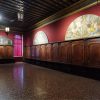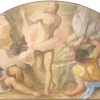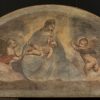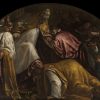Housing one of the three Councils of Forty, the highest appeal courts in the Venetian Republic, this is another room used in the administration of justice. The Quarantia Criminal was set up in the fifteenth century and, as the name suggests, dealt with cases of criminal law. It was a very important body as its members, who were part of the Senate as well, also had legislative powers. The wooden stalls date from the seventeenth century.
WORKS ON DISPLAY:
Giuseppe Porta, known as Salviati (1520-1575)
Resurrection of Christ
ca. 1560
Detached fresco transferred to canvas
Giuseppe Porta, known as Salviati, trained in Rome in the workshop of Francesco Salviati (1510-1563). In 1539 he moved to Venice together with his master, and here he was involved in numerous commissions. Among these is the lunette with the Resurrection of Christ. The work was originally located next to Titian’s Virgin and Child with Two Angels on the staircase leading to the Church of San Nicolò, commissioned by Doge Andrea Gritti (1523-1538, and most likely suffered the same fate as Titian’s fresco: due to the deterioration of its state of conservation, it was torn and glued onto canvas.
The composition takes up the Resurrection of Christ also created by Giuseppe Porta for the convent of Santa Maria della Salute and now preserved in the Gallerie dell’Accademia in Venice.
Titian (1488-1576)
Virgin and Child with Two Angels
1525-1530
Detached fresco transferred to canvas
The fresco was located on the staircase leading to the Church of San Nicolò. Inaugurated on December 6, 1523 during the reign of Andrea Gritti (1523-1538), the small church replaced the previous chapel of the same name, located in a different room of Palazzo Ducale.
In Le Meraviglie dell’arte (1648), Carlo Ridolfi recalls: “At the foot of the stairs of the same Palace is the figure of Our Lady above the clouds, who with sweet charm admires the baby Jesus lying in her virginal womb”. Already in the eighteenth century the work was in a poor state of conservation, but only in 1899 was it decided to tear it from its original location and transfer it onto canvas.
Titian’s composition of the Virgin and Child enchants with the intense emotional component that links the gaze of the mother to that of her son: the Virgin tenderly holds the foot of baby Jesus, while he extends a hand to caress his mother’s cheek.
Giovanni Bellini (1438/1440-1516)
Pietà (1472)
Oil and tempera on canvas
This Pietà is the only surviving testimony within the Doge’s Palace of Giovanni Bellini’s activity as official painter of the Serenissima Republic. Most likely commissioned to decorate the ancient chapel of San Nicolò, the work underwent numerous moves over time, up to its current location in the Quadreria [Picture Gallery].
The painting depicts the lifeless Christ supported by Mary and John in the foreground, while on the sides Saints Nicholas and Mark are gathered in prayer. The great emotional intensity of the scene emanates both from the faces of the saints disfigured by crying and from the wounded body of Jesus. In this case the tombstone becomes the altar of sacrifice, with the two candelabras which refer to the Eucharistic celebration.
The presence of the signature and date on the cartouche – the latter having disappeared, but attested by numerous sources (Ridolfi 1648, Zanetti 1771) – confirm the authorship of Giovanni Bellini.
In 1571, by will of three Avogadori (Michele Bon, Francesco Pisani and Ottaviano Valier), two landscape extensions by Paolo Farinati were added to the painting, thus altering its format and making it rectangular.
Only in 1948, in view of the monographic exhibition on Giovanni Bellini at Palazzo Ducale, was it decided to restore the painting by eliminating the sixteenth-century additions, thus getting back to the original composition.
Pietro Malombra (1556-1618)
The Submission of the Emperor Frederick Barbarossa to Pope Alexander III
beginning of the 17th century
Oil on canvas
The lunette, together with the pendant showing Pope Alexander III Grants the Indulgence to the Church of San Giacomo di Rialto, was commissioned at the beginning of the 17th century to Pietro Malombra for the church of San Giacomo di Rialto in Venice.
The canvas depicts a fundamental episode in Venetian history: in 1177, after years of war, Pope Alexander III and Emperor Frederick Barbarossa met in Venice thanks to the intercession of Doge Sebastiano Ziani (1172-1178), stipulating peace.
In the painting, the emperor is represented kneeling before the pope, while on the left side is doge Sebastiano Ziani, to whom the painter attributed the features of the doge Marino Grimani (1595-1605).
He was the patron of the restoration of the church of San Giacomo di Rialto, partially damaged by a fire in 1514.
Pietro Malombra (1556-1618)
Pope Alexander III Grants the Indulgence to the Church of San Giacomo di
Rialto
beginning of the 17th century
Oil on canvas
The historical event narrated in this lunette dates back to July 25, 1177, St. James’s Day, when Pope Alexander III granted the bull of plenary indulgence, which allowed all those who visited the church on St. James’s Day to obtain forgiveness of sins. The pope is depicted by Pietro Malombra in the act of delivering the bull to the priest in the presence of the kneeling doge.
The painting is the companion piece to the Submission of the Emperor Frederick Barbarossa to Pope Alexander III.





